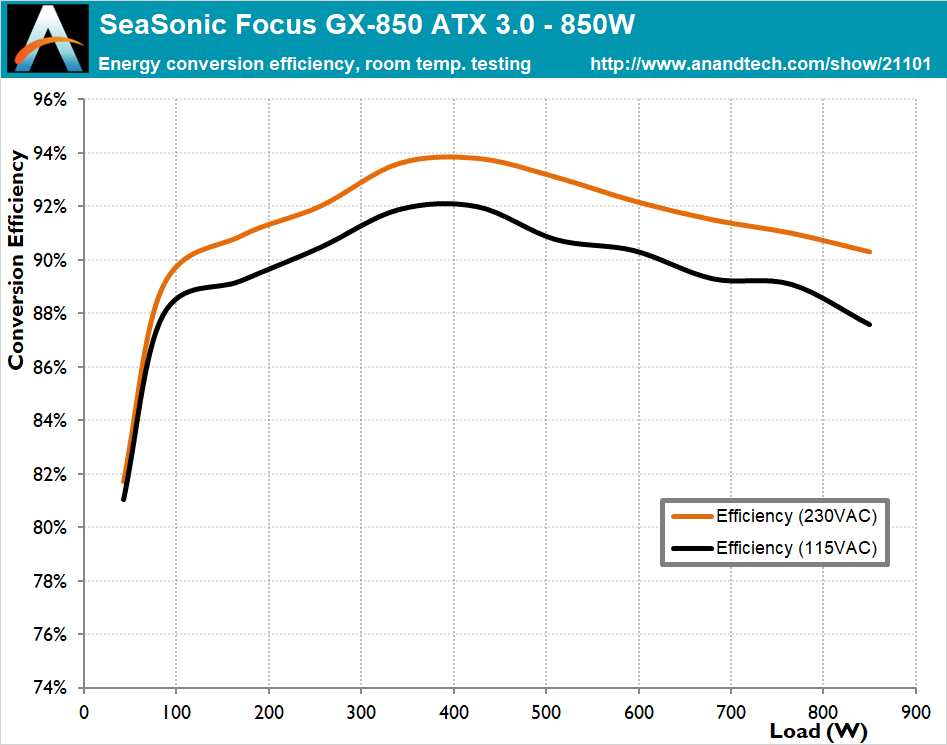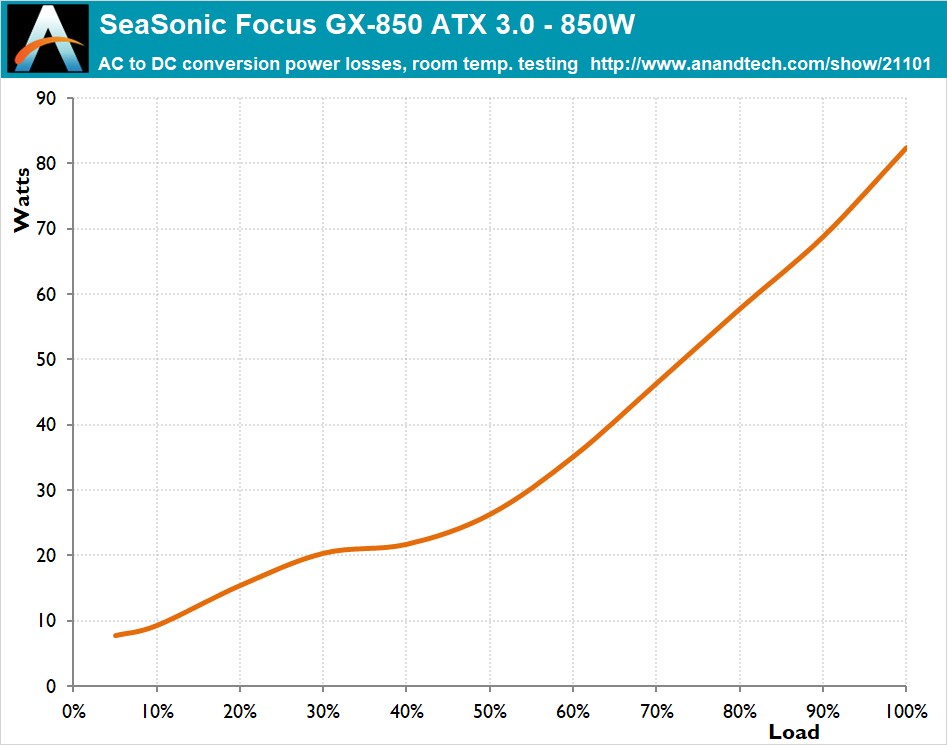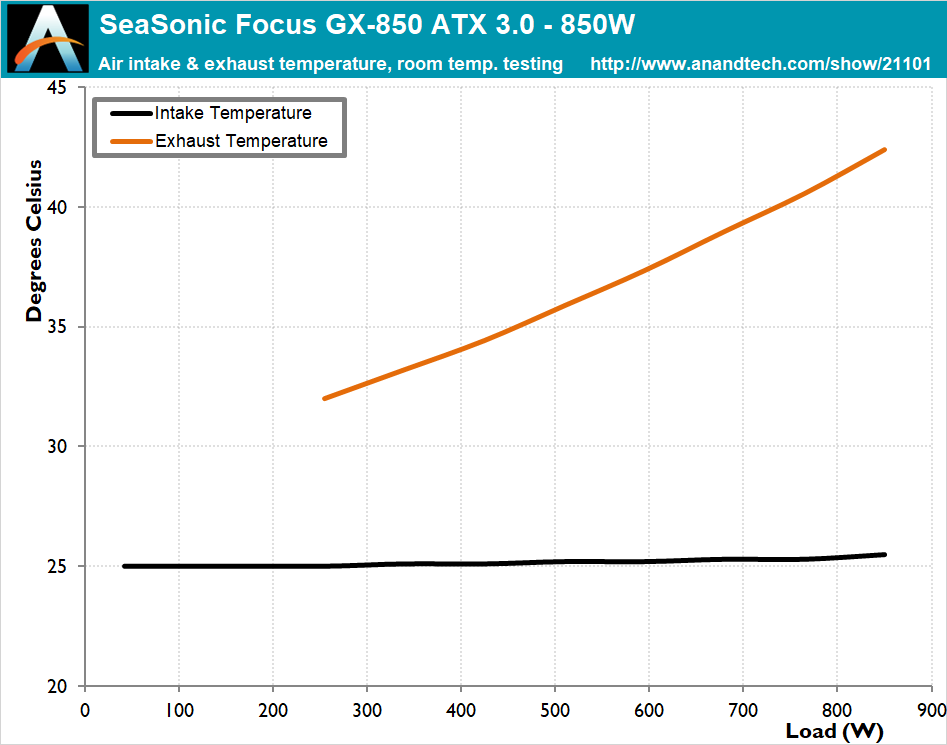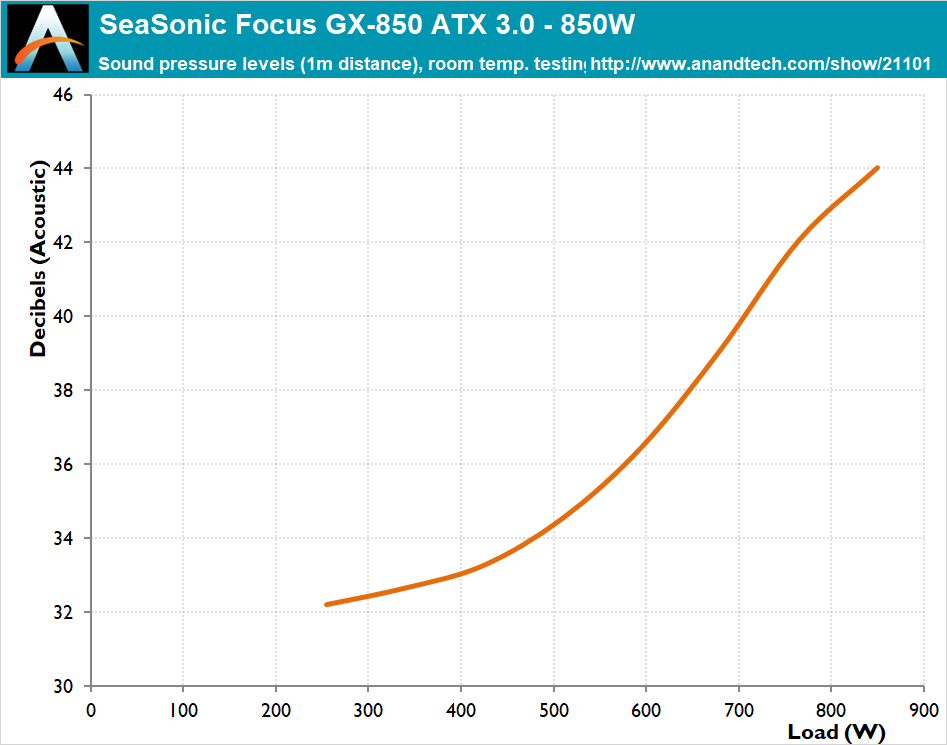The SeaSonic Focus GX-850 ATX 3.0 PSU Review: Cool, Quiet, and Robust
by E. Fylladitakis on November 29, 2023 8:00 AM EST- Posted in
- Cases/Cooling/PSUs
- Seasonic
- PSUs
- 80Plus Gold
- 850W
- ATX v3.0
- 12VHPWR
Cold Test Results (~25°C Ambient Temperature)
For the testing of PSUs, we are using high precision electronic loads with a maximum power draw of 2700 Watts, a Rigol DS5042M 40 MHz oscilloscope, an Extech 380803 power analyzer, two high precision UNI-T UT-325 digital thermometers, an Extech HD600 SPL meter, a self-designed hotbox and various other bits and parts. For a thorough explanation of our testing methodology and more details on our equipment, please refer to our How We Test PSUs - 2014 Pipeline post.
The SeaSonic Focus GX-850 exhibits particularly high energy conversion efficiency for an 80Plus Gold unit, narrowly missing the 80Plus Platinum certification for an input voltage of 115 VAC due to a slight dip at maximum load. Its efficiency with an input voltage of 230 VAC is also very high for an 80Plus Gold-certified unit, with an average efficiency across the nominal loading range of 92%. The average efficiency drops to 90.1% if the input voltage is 115 VAC, a very significant 1.9% drop, yet it remains very high for an 80Plus Gold-certified product.
In its default setting on the SeaSonic Focus GX-850, the thermal control operates in a semi-fanless mode, which signifies that the fan activation is contingent on the requisite cooling demand. With the unit operating at room temperature, the fan activates when the load is greater than 240 Watts. This approach, while fostering quieter operation under low to moderate loads, leads to a relative elevation in the internal temperatures of the PSU prior to fan engagement. That, however, is virtually insignificant, as the fan engages long before the temperatures reach threatening figures.
As mentioned above, the SeaSonic Focus GX-850 has its fan remaining inactive until the load surpasses a defined wattage. Once activated, the fan operates at a virtually inaudible sound pressure level until the load extends beyond half the unit’s rated capacity. Beyond this load threshold, the thermal controller progressively augments the fan speed to adeptly manage the escalating cooling demands of the PSU, thereby ensuring a harmonious balance between operational efficiency, thermal management, and acoustic comfort.















24 Comments
View All Comments
GeoffreyA - Wednesday, November 29, 2023 - link
It's beautiful.Techie2 - Wednesday, November 29, 2023 - link
This is another high quality PSU from Seasonic. They are the gold standard in PC PSUs IMNHO.HaninAT - Wednesday, November 29, 2023 - link
My only issue is that I just bought their prior generation Focus GX 850... Oh well... I will need the new fangled PCI-EX power lead eventually anyway.Samus - Wednesday, November 29, 2023 - link
This exact fan failed on my Seasonic Focus GX-700 after 2 years. It started making rattling noises, the shaft inside the hub rounded itself out of the bearing. Replacing it was a pain in the ass because the fan controller is calibrated for a specific amp fan, and if you use one thats rated over or under the stock fan, it will either spin faster or not spin at all, the later of which was my issue because I upgraded the fan to a beefier ball bearing NMB.Seasonic should get a clue and use ball bearing fans in PSU's they market as premium and charge top dollar for. A quick google search will reveal I am far from the only one with a Seasonic PSU fan failure, and while its under warranty, you will be without a PSU for 2 weeks during the RMA process as they do not offer advanced RMA, and the process itself is a frustrating social experiment I lost patience with and opted not to go through.
sonny73n - Wednesday, November 29, 2023 - link
I would just replace the fail fan with a case fan and connecti it to the motherboard. The silent/fan-stop feature is unnecessary because one more running fan would not make a different.Samus - Thursday, November 30, 2023 - link
If you don't have a fan connected to the PSU, the fan controller prevents the PSU from powering on because it thinks the fan is dead. You could put a resistor in to trick it, but then you are faced with a fan that is running independently of the PSU, disregarding its temperature zone. Sure, you could put a fan in that runs at full speed, it would be noisier than necessary. Or you could roll the dice and try running the fan based on case or CPU temperature which would theoretically scale with PSU load, but...all Seasonic needed to do to avoid ALL OF THIS BS is to put a reliable fan in their PSU's.I have a 15 year old PC Power & Cooling Silencer 750 that has way beyond 100,000 hours on it. Original fan, still silent.
liquid_c - Monday, December 18, 2023 - link
15 years equals ~129600 hours. You ran over 100.000 hours during this time? 11 and a half years of non-stop running? I find it hard to believe.bernstein - Wednesday, November 29, 2023 - link
Why do they still make those huge PSUs with those silly huge and ancient atx power plugs?I mean all it does is converting to 12V power… the rest is just useless 5v/3v stuff for long obsolete tech like 2.5” hdds…
bernstein - Wednesday, November 29, 2023 - link
Also, who the hell still needs 10 sata, 3 molex & 1 floppy power plugs. Those things are ancient (well 3.5” hdds are still a thing but, still motherboards with more than 4 sata ports are getting rare…evanh - Thursday, November 30, 2023 - link
Dude, that's why it's modular. And can even cut off what you don't want.